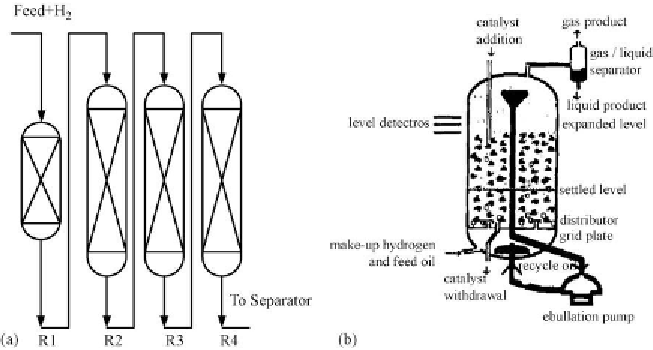Environmental Engineering Reference
In-Depth Information
the extinction. Apparently, almost complete conversion of the atmospheric residues (AR)
could be achieved. The fixed bed reactors, which are part of the Gulf RDS process
[132]
,
consist of several sections in one reactor vessel, similarly as it is in the Chevron RDS (VRDS)
process. Using these processes, a high level of HDS could be achieved with a proper catalyst
selection. The Chevron RDS process has also been used downstream of deasphalting unit for
the upgrading of DAO
[133]
. With the proprietary catalyst designed for this process, a high
level of HDS and a low H
2
consumption could be achieved. The EXXON Residfining process
consists of a guard reactor and the catalytic reactor comprising several sections
[134]
. This
process was designed for the HDS of the atmospheric residues obtained from conventional
crudes with the aim to produce fuel oils meeting all commercial specifications.
3.4.1.2 Atmospheric Residue Desulfurization (ARDS) and HYVAHL Processes
The new processes employing fixed bed reactors (
Fig. 3.13
) comprising various combinations
of reactors and catalysts were developed in response to new developments in refining industry.
A brief description of the HYVAHL process and ARDS process is given as an illustration of
the efforts to modify fixed bed reactors for hydroprocessing of the asphaltenes and metals
containing heavy feeds. The ARDS process was developed by Unocal for hydroprocessing of
atmospheric residues. Simplified schematic of this process is shown in
Fig. 3.13
. Apparently,
this is an extension of the Unibon process to accommodate more problematic feeds. There are
many years of experience in the commercial operation of this process using Kuwait AR,
typically containing about 85 ppm of V+Ni and about 12 wt.% of CCR
[135]
. In this case, the
process consists of two trains each having design capacity of 33,000 barrels per day. Each train
comprises one guard reactor and three main reactors with a common fractionation section
Figure 3.13: Simplified schematics of (a) atmospheric residue desulfurization (ARDS) process and
(b) ebullated bed reactor.









